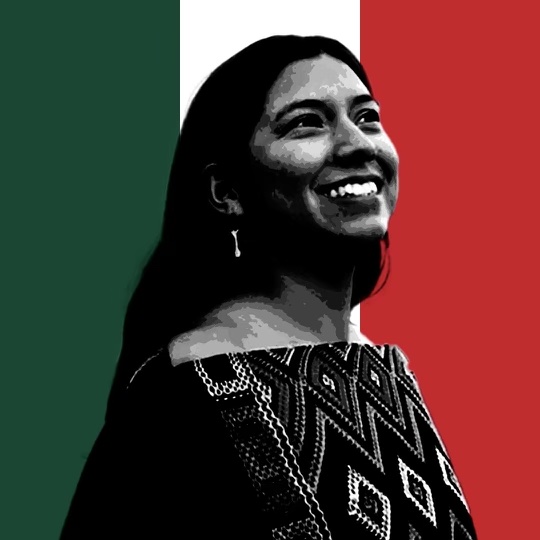San Cristóbal de las Casas, Chiapas, Mexico – “Resist, Resist, Resist” read the words on Mitzy Violeta Cortés’s t-shirt as she joins a dozen other activists on campus at the Universidad de la Tierra. The school is the day’s designated gathering place for the conclusion of El Sur Resiste (The South Resists), a two-week-long campaign through six states in southern Mexico to protest against large-scale environmental degradation and advocate for Indigenous sovereignty.
It is early May, but the heat in Mexico’s Chiapas state – which borders Guatemala along its southern edge – is already severe. The rainy season has not yet arrived, meaning the humidity is high. Beads of sweat collect along the young protesters’ faces, but they do not seem to notice. An initiative launched by the youth-led environmental justice group Red de Futuros Indígenas (Indigenous Futures Network), El Sur Resiste adopted a caravan-style activism model as protesters made stops in small villages across Chiapas, Oaxaca, Veracruz, Tabasco, Campeche, Yucatán and Quintana Roo. In each location, Cortés and her peers engaged with remote populations typically overlooked by environmentalist efforts to coalition-build in the region.

At 24, Cortés already understands that environmental degradation in Mexico – and indeed in many other parts of the world – is intimately linked to cultural devastation threatening Indigenous communities. In Mexico, the federal government’s mega-infrastructure projects bring an onslaught of challenges to Indigenous communities and the land on which they reside. President Andrés Manuel López Obrador, or AMLO, as he is called by the Mexican people, has received international attention for his accelerated construction of the Tren Maya. When completed, the train route will connect the eastern tourist city of Cancún to the rest of the Yucatán Peninsula and existing train lines extending as far west as Mexico City. The project is promoted on the basis of economic expansion, similar to that of its sister endeavor Corredor Interoceánico, AMLO’s plan for rehabilitating economic activity between the Gulf of Mexico and the Pacific Ocean. Both have been widely condemned by Indigenous communities, who call the projects extractive and “ecocidal”.
The challenge now, according to Cortés, is turning community-level condemnation into organized resistance that reaches international audiences. Even as construction crews plow ahead, Cortés maintains that resistance efforts must not cease. There is power in numbers, she says, but that power only emerges if information is disseminated to those affected most by the government’s projects.
Cortés, who was raised in San Sebastián Tecomaxtlahuaca, a small village in southwestern Oaxaca, remembers when she first discovered the divide between rural communities and the urban perception of them. Upon studying at the National Autonomous University of Mexico in Mexico City, Cortés realized her experiences growing up as a Mixteca woman in an Indigenous community were disconnected from the discussion of such topics at an institutional level.
“There are other realities in Mexico outside of what happens in the cities,” Cortés says. “Many people didn’t know what was happening in rural communities, in farming communities, in Indigenous communities.”
Shortly after making this observation, Cortés got involved with Futuros Indígenas. During her tenure, Cortés has worked to co-found the group’s Milpamérica initiative, bringing the principles of Mexico’s growing youth climate activism into Guatemala, Honduras and El Salvador. Named for the milpa, a traditional method of cultivating crops in Mesoamerica, the initiative’s name pays homage to a tradition dating back thousands of years. Cortés characterizes her role with Milpamérica and Futuros Indígenas as one of “defense” as she seeks to inform broad audiences about the climate crisis.
“For us, ‘defense’ implies defending the land, the forests and the rivers, but it also implies defending Indigenous identity, language, knowledge and forms of understanding the world around us,” Cortés says. “For us, ‘defense’ includes all of it; not just denouncing the damage done to the planet, but also denouncing violence.”
Cortés’s work models other efforts around the world and especially in other parts of Latin America. Cura Da Terra, an environmental campaign led by Indigenous women in Brazil and Guatemala, is one example of activism from which Cortés draws inspiration. In addition to producing a three-part documentary series in 2021, the effort also organized the Global Gathering of Indigenous Women at the 26th Conference of the Parties (COP26), the United Nations’ annual conference on climate change.
“In times of pandemic, ecocide and genocide, we the Indigenous women who cure our bodies, territories and spirits are living solutions to the climate crisis,” Cura Da Terra posted to its website before the conference. “We call on our sisters to sow seeds of hope, to reforest hearts.”
In Mexico, Cortés keeps her focus first on local realities. Through efforts like El Sur Resiste, Cortés brings attention to the climate crisis as it is experienced by small and Indigenous communities, amplifying their voices and concerns at national and international levels.
“It’s about being able to articulate the issue, about being able to say, ‘Look, what is happening in this community is also happening in mine,’” Cortés says.
Still, communication remains a challenge. Recently, Futuros Indígenas has begun educational initiatives that provide communities with tools for processing their experiences. The efforts involve working in primary schools to introduce environmental topics and community-oriented language. The objective, says Cortés, is to teach Indigenous children to value their land and culture while helping them understand that what occurs in their communities takes place in a broader context of climate change, industrialization and external development.
“I think the most difficult thing has just been bringing visibility to some of these stories,” Cortés says. “There is very little space where the perspectives of local people are developed.”
With the use of technology, however, Cortés is optimistic that new spaces can be made available for communities to reach broader audiences. Harnessing social media and audio and video content production, Cortés believes rural communities in Mexico and other parts of Central America can make their voices heard. She says narratives are particularly important for climate activism and communication since it is stories that most often invoke camaraderie between people, inspiring them to rethink their habits.
Of course, Cortés knows that the issues to which she dedicates herself are relevant on more than a regional level alone. A participant in Yale Global University’s 2020 Climate Forum and the 2022 winner of the Global Citizen Prize, Cortés recognizes that sustainable, large-scale change will come from international cooperation.
Offering advice to her peer activists in the United States, Cortés focuses her attention on advocating for Indigenous rights and calling for the end of racially-motivated violence. She says she would challenge young Americans to imagine a future where we do not replicate the same violence against people and land that has colored the past. Adding that we are fortunate to be living in a moment where mental health and wellness are a part of the conversation, Cortés frames activism in a new lens for members of younger generations. She says we cannot talk about finding a solution for our planet if we do not also pay attention to the harm we have inflicted on ourselves and our own psyches.
While reflection and reconciliation is important, Cortés does not believe the work of a climate activist always has to be so heavy. Months after the hot day gathered with her fellow activists in Chiapas, Cortés sits in front of her computer at her home in Oaxaca. She logs onto her Instagram page, where she is connected to a network of thousands of other young people compelled toward the same cause as her. She smiles. “What do we want to build?” She asks. There is so much about the future still to design.



